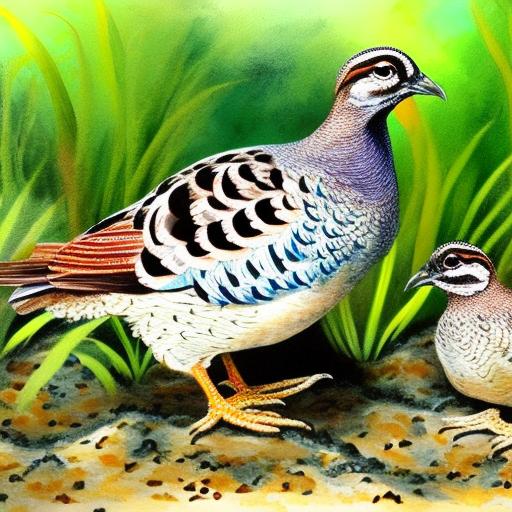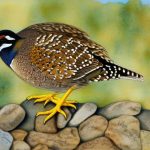Breeding Mexican Speckled Quail can be a rewarding and profitable venture for those interested in poultry farming. These small, attractive birds are known for their beautiful speckled plumage and are popular among hobbyists and commercial breeders alike. Mexican Speckled Quail are relatively easy to care for and can adapt well to a variety of climates, making them an ideal choice for breeders in different regions. In this article, we will explore the various aspects of breeding Mexican Speckled Quail, including selecting breeding stock, housing and equipment, breeding and incubation, chicks and brooding, feeding and care, as well as common health issues and solutions.
Key Takeaways
- Mexican Speckled Quail breeding is a rewarding and relatively easy endeavor for those interested in raising these unique birds.
- When selecting breeding stock, it is important to choose healthy, unrelated birds with desirable traits such as good size, color, and temperament.
- Proper housing and equipment are essential for Mexican Speckled Quail breeding, including spacious cages, nesting boxes, and a reliable incubator.
- Breeding and incubation require careful monitoring of egg production, fertility, and temperature and humidity levels in the incubator.
- Chicks and brooding require a warm, clean, and safe environment with access to proper nutrition and water to ensure their healthy development.
Selecting Breeding Stock
When it comes to breeding Mexican Speckled Quail, selecting the right breeding stock is crucial for producing healthy and high-quality offspring. It is important to choose birds that are free from any genetic defects or diseases, as these can be passed down to the next generation. Look for birds that are active, alert, and have good body conformation. Additionally, it is advisable to select breeding stock from different bloodlines to avoid inbreeding and maintain genetic diversity within the flock. When selecting breeding stock, pay attention to the birds’ plumage color and markings, as these are important traits that breeders aim to preserve and improve through selective breeding. By carefully choosing the best breeding stock, breeders can ensure the production of strong and healthy Mexican Speckled Quail chicks.
Housing and Equipment
Proper housing and equipment are essential for successful Mexican Speckled Quail breeding. The quail should be housed in a secure and well-ventilated coop or aviary that provides protection from predators and the elements. The coop should have adequate space for the birds to move around freely and should be equipped with nesting boxes for egg-laying. It is important to provide a clean and dry bedding material, such as straw or wood shavings, to keep the birds comfortable and prevent the buildup of moisture and bacteria. Additionally, the coop should have access to natural light and be equipped with artificial lighting to ensure proper egg production and reproductive health. Waterers and feeders should be placed at a convenient height for the quail to access easily, and they should be regularly cleaned and refilled to ensure the birds have a constant supply of fresh water and feed.
Breeding and Incubation
Breeding Mexican Speckled Quail can be a straightforward process if the right conditions are provided. To encourage breeding, it is important to maintain a proper male-to-female ratio within the flock, with one male for every three to five females. This will help prevent overbreeding and aggression among the males. The quail should be provided with a diet rich in protein and essential nutrients to support reproductive health and egg production. Once the eggs are laid, they can either be left in the nesting boxes for the hens to incubate or collected and placed in an artificial incubator. The incubation period for Mexican Speckled Quail eggs is approximately 16-18 days, during which the eggs should be kept at a consistent temperature and humidity level. It is important to regularly monitor the eggs for signs of development and remove any that appear to be infertile or damaged.
Chicks and Brooding
Once the eggs hatch, the chicks will need to be carefully monitored and provided with a warm and safe environment for their first few weeks of life. Brooding pens or brooders should be set up with heat lamps or heating pads to maintain a temperature of around 95-100 degrees Fahrenheit for the first week, gradually decreasing by 5 degrees each week until they reach room temperature. The chicks should be provided with a non-slippery surface such as paper towels or rubber mats to prevent leg deformities, as well as access to clean water and chick starter feed. It is important to closely observe the chicks for any signs of illness or weakness and provide immediate care if needed. Proper brooding practices are essential for ensuring the healthy growth and development of Mexican Speckled Quail chicks.
Feeding and Care

Feeding plays a crucial role in the overall health and development of Mexican Speckled Quail. A balanced diet that is high in protein is essential for supporting growth, reproduction, and overall vitality. Commercially available quail feed or game bird feed can be supplemented with fresh greens, fruits, and vegetables to provide additional nutrients and variety. It is important to provide clean water at all times, as quail can quickly become dehydrated if water is not readily available. Additionally, regular health checks should be conducted to monitor for any signs of illness or parasites, and appropriate measures should be taken to address any health issues that may arise. Providing proper care and nutrition will help ensure that Mexican Speckled Quail remain healthy and productive.
Common Health Issues and Solutions
Like any poultry species, Mexican Speckled Quail are susceptible to a range of health issues that can impact their well-being and productivity. Common health issues include respiratory infections, parasites, injuries, and nutritional deficiencies. To prevent these issues, it is important to maintain a clean and hygienic living environment for the quail, provide a balanced diet, and regularly monitor their health. If health issues do arise, it is important to seek veterinary advice and administer appropriate treatment as soon as possible. Additionally, implementing biosecurity measures can help prevent the spread of diseases within the flock. By staying vigilant and proactive in addressing potential health issues, breeders can help ensure the long-term health and success of their Mexican Speckled Quail breeding operation.
In conclusion, breeding Mexican Speckled Quail can be a fulfilling endeavor for those passionate about poultry farming. By carefully selecting breeding stock, providing proper housing and equipment, managing breeding and incubation, caring for chicks, ensuring proper nutrition, and addressing common health issues, breeders can successfully raise healthy Mexican Speckled Quail while maintaining high standards of quality and productivity within their flock. With dedication, knowledge, and attention to detail, breeders can enjoy the rewards of producing these beautiful birds while contributing to the preservation of this unique quail species.
If you’re interested in Mexican speckled quail breeding, you may also want to consider the importance of providing a suitable environment for your quail. A well-designed chicken coop can serve as a great model for a quail enclosure. Check out this article on where to put a chicken coop for insights on creating an optimal living space for your quail. Understanding the principles of coop placement can help ensure the health and productivity of your quail breeding operation.
FAQs
What is the breeding season for Mexican speckled quail?
The breeding season for Mexican speckled quail typically occurs from late spring to early summer, with peak breeding activity in May and June.
How many eggs does a female Mexican speckled quail typically lay?
A female Mexican speckled quail can lay anywhere from 8 to 12 eggs in a single clutch, with an average of 10 eggs being the most common.
What is the incubation period for Mexican speckled quail eggs?
The incubation period for Mexican speckled quail eggs is approximately 16 to 18 days.
What is the recommended temperature and humidity for incubating Mexican speckled quail eggs?
The recommended temperature for incubating Mexican speckled quail eggs is around 99.5 degrees Fahrenheit, with a humidity level of 50-60% for the first 14 days, and then increased to 65-70% for the final days of incubation.
At what age do Mexican speckled quail chicks typically start to fly?
Mexican speckled quail chicks typically start to fly at around 2 weeks of age.
What is the average lifespan of Mexican speckled quail?
The average lifespan of Mexican speckled quail is around 3 to 5 years in captivity.
Meet Walter, the feathered-friend fanatic of Florida! Nestled in the sunshine state, Walter struts through life with his feathered companions, clucking his way to happiness. With a coop that’s fancier than a five-star hotel, he’s the Don Juan of the chicken world. When he’s not teaching his hens to do the cha-cha, you’ll find him in a heated debate with his prized rooster, Sir Clucks-a-Lot. Walter’s poultry passion is no yolk; he’s the sunny-side-up guy you never knew you needed in your flock of friends!







